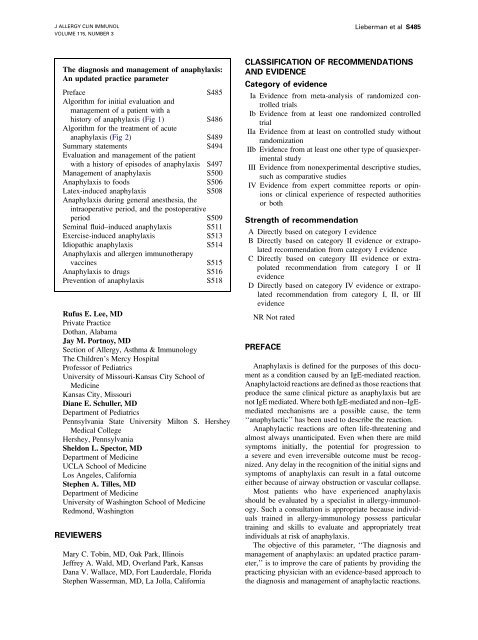Immunotherapy Safety for the Primary Care ... - U.S. Coast Guard
Immunotherapy Safety for the Primary Care ... - U.S. Coast Guard
Immunotherapy Safety for the Primary Care ... - U.S. Coast Guard
Create successful ePaper yourself
Turn your PDF publications into a flip-book with our unique Google optimized e-Paper software.
J ALLERGY CLIN IMMUNOL<br />
VOLUME 115, NUMBER 3<br />
Lieberman et al S485<br />
The diagnosis and management of anaphylaxis:<br />
An updated practice parameter<br />
Preface<br />
S485<br />
Algorithm <strong>for</strong> initial evaluation and<br />
management of a patient with a<br />
history of anaphylaxis (Fig 1)<br />
S486<br />
Algorithm <strong>for</strong> <strong>the</strong> treatment of acute<br />
anaphylaxis (Fig 2)<br />
S489<br />
Summary statements<br />
S494<br />
Evaluation and management of <strong>the</strong> patient<br />
with a history of episodes of anaphylaxis S497<br />
Management of anaphylaxis<br />
S500<br />
Anaphylaxis to foods<br />
S506<br />
Latex-induced anaphylaxis<br />
S508<br />
Anaphylaxis during general anes<strong>the</strong>sia, <strong>the</strong><br />
intraoperative period, and <strong>the</strong> postoperative<br />
period<br />
S509<br />
Seminal fluid–induced anaphylaxis S511<br />
Exercise-induced anaphylaxis<br />
S513<br />
Idiopathic anaphylaxis<br />
S514<br />
Anaphylaxis and allergen immuno<strong>the</strong>rapy<br />
vaccines<br />
S515<br />
Anaphylaxis to drugs<br />
S516<br />
Prevention of anaphylaxis<br />
S518<br />
Rufus E. Lee, MD<br />
Private Practice<br />
Dothan, Alabama<br />
Jay M. Portnoy, MD<br />
Section of Allergy, Asthma & Immunology<br />
The Children’s Mercy Hospital<br />
Professor of Pediatrics<br />
University of Missouri-Kansas City School of<br />
Medicine<br />
Kansas City, Missouri<br />
Diane E. Schuller, MD<br />
Department of Pediatrics<br />
Pennsylvania State University Milton S. Hershey<br />
Medical College<br />
Hershey, Pennsylvania<br />
Sheldon L. Spector, MD<br />
Department of Medicine<br />
UCLA School of Medicine<br />
Los Angeles, Cali<strong>for</strong>nia<br />
Stephen A. Tilles, MD<br />
Department of Medicine<br />
University of Washington School of Medicine<br />
Redmond, Washington<br />
REVIEWERS<br />
Mary C. Tobin, MD, Oak Park, Illinois<br />
Jeffrey A. Wald, MD, Overland Park, Kansas<br />
Dana V. Wallace, MD, Fort Lauderdale, Florida<br />
Stephen Wasserman, MD, La Jolla, Cali<strong>for</strong>nia<br />
CLASSIFICATION OF RECOMMENDATIONS<br />
AND EVIDENCE<br />
Category of evidence<br />
Ia Evidence from meta-analysis of randomized controlled<br />
trials<br />
Ib Evidence from at least one randomized controlled<br />
trial<br />
IIa Evidence from at least on controlled study without<br />
randomization<br />
IIb Evidence from at least one o<strong>the</strong>r type of quasiexperimental<br />
study<br />
III Evidence from nonexperimental descriptive studies,<br />
such as comparative studies<br />
IV Evidence from expert committee reports or opinions<br />
or clinical experience of respected authorities<br />
or both<br />
Strength of recommendation<br />
A Directly based on category I evidence<br />
B Directly based on category II evidence or extrapolated<br />
recommendation from category I evidence<br />
C Directly based on category III evidence or extrapolated<br />
recommendation from category I or II<br />
evidence<br />
D Directly based on category IV evidence or extrapolated<br />
recommendation from category I, II, or III<br />
evidence<br />
NR Not rated<br />
PREFACE<br />
Anaphylaxis is defined <strong>for</strong> <strong>the</strong> purposes of this document<br />
as a condition caused by an IgE-mediated reaction.<br />
Anaphylactoid reactions are defined as those reactions that<br />
produce <strong>the</strong> same clinical picture as anaphylaxis but are<br />
not IgE mediated. Where both IgE-mediated and non–IgEmediated<br />
mechanisms are a possible cause, <strong>the</strong> term<br />
‘‘anaphylactic’’ has been used to describe <strong>the</strong> reaction.<br />
Anaphylactic reactions are often life-threatening and<br />
almost always unanticipated. Even when <strong>the</strong>re are mild<br />
symptoms initially, <strong>the</strong> potential <strong>for</strong> progression to<br />
a severe and even irreversible outcome must be recognized.<br />
Any delay in <strong>the</strong> recognition of <strong>the</strong> initial signs and<br />
symptoms of anaphylaxis can result in a fatal outcome<br />
ei<strong>the</strong>r because of airway obstruction or vascular collapse.<br />
Most patients who have experienced anaphylaxis<br />
should be evaluated by a specialist in allergy-immunology.<br />
Such a consultation is appropriate because individuals<br />
trained in allergy-immunology possess particular<br />
training and skills to evaluate and appropriately treat<br />
individuals at risk of anaphylaxis.<br />
The objective of this parameter, ‘‘The diagnosis and<br />
management of anaphylaxis: an updated practice parameter,’’<br />
is to improve <strong>the</strong> care of patients by providing <strong>the</strong><br />
practicing physician with an evidence-based approach to<br />
<strong>the</strong> diagnosis and management of anaphylactic reactions.
















